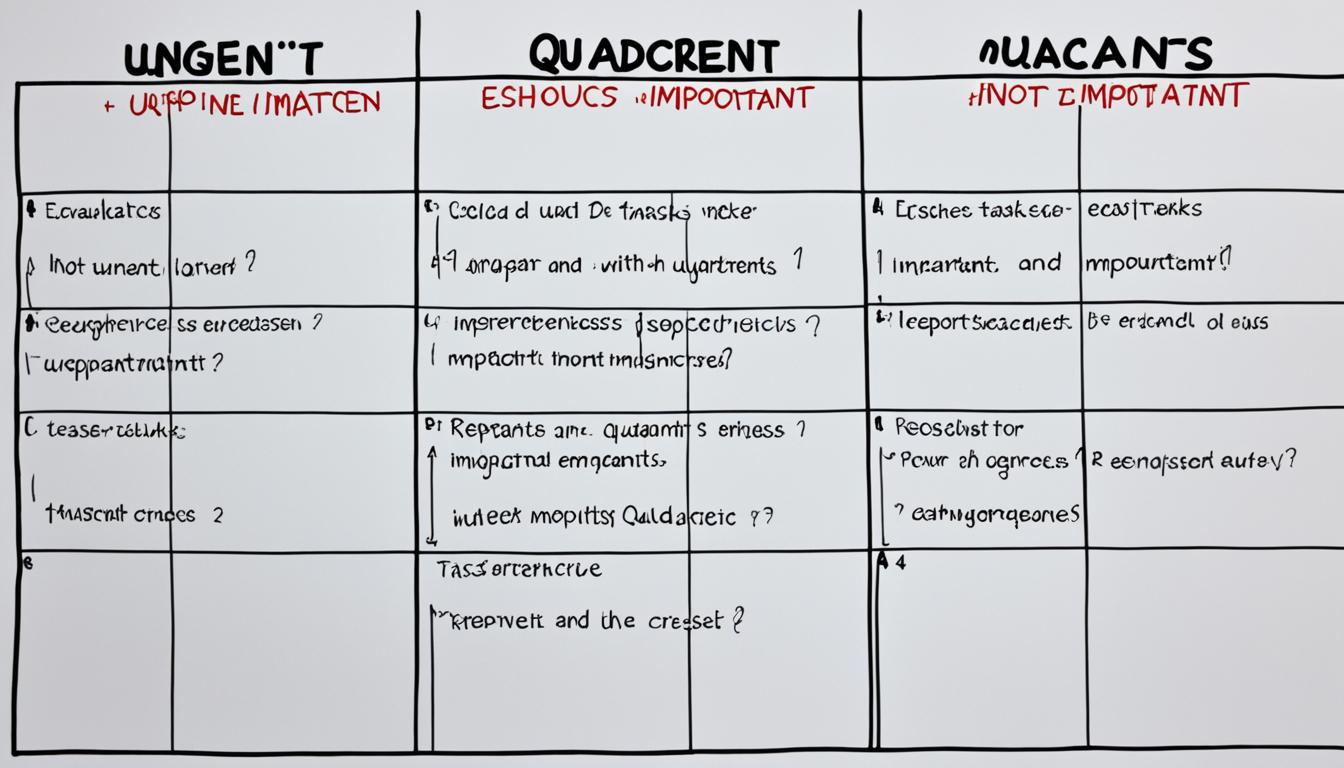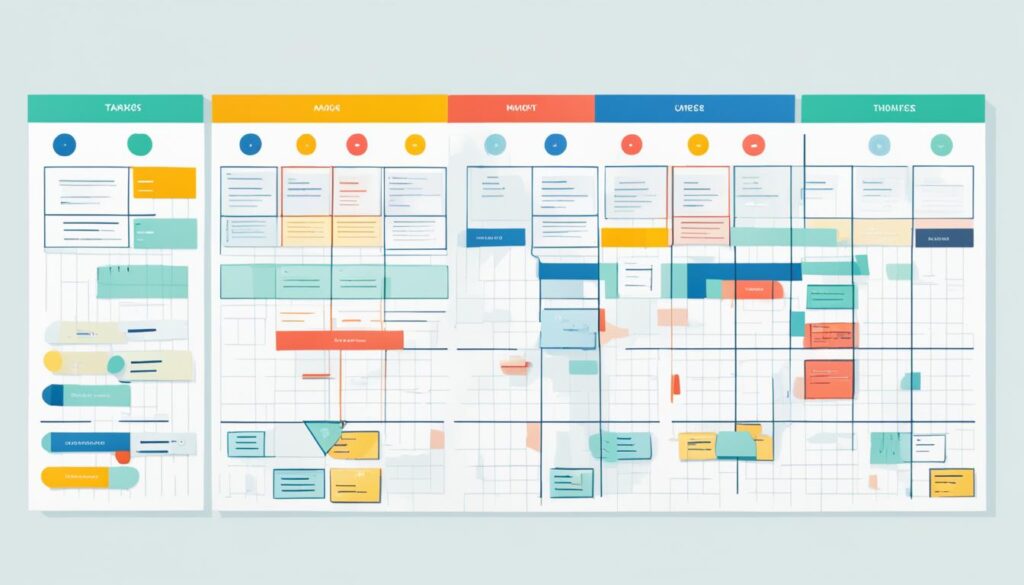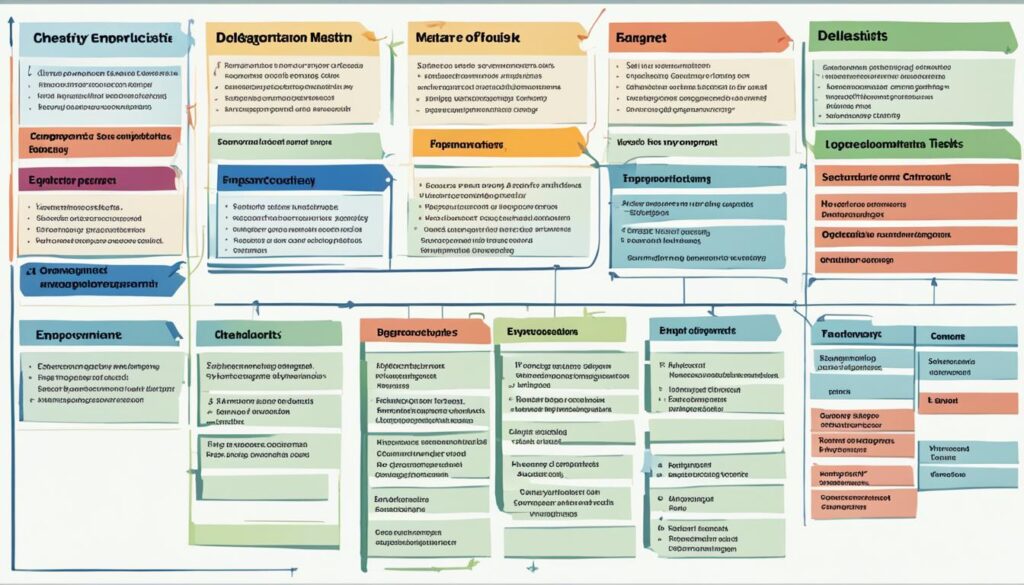Master Your Day with the Time Management Matrix

“The key is not to prioritize what’s on your schedule, but to schedule your priorities.” – Stephen Covey
Time is a finite resource, and managing it effectively is crucial for success in both personal and professional endeavors. In a world filled with endless distractions and competing demands, it’s easy to lose sight of what truly matters. This is where the time management matrix comes in.
The time management matrix, also known as the Eisenhower matrix, is a powerful tool for prioritizing tasks and improving productivity. Developed by Dwight D. Eisenhower, the 34th President of the United States, and popularized by Stephen Covey in his book “The 7 Habits of Highly Effective People,” this matrix categorizes tasks into four quadrants based on their urgency and importance.
By using the time management matrix, individuals can allocate their time strategically and focus on what truly matters. It helps us distinguish between urgent and important tasks, enabling us to prioritize effectively and make the most of our limited time and energy.
Key Takeaways:
- Time is a valuable resource that needs to be managed effectively.
- The time management matrix is a powerful tool for prioritizing tasks.
- It categorizes tasks into four quadrants based on their urgency and importance.
- By prioritizing tasks using the matrix, individuals can focus on what truly matters.
- Remember Stephen Covey’s quote: “The key is not to prioritize what’s on your schedule, but to schedule your priorities.”
Understanding the Urgent vs. Important Breakdown
The key to effectively using the time management matrix is understanding the distinction between urgent and important tasks. Urgent tasks require immediate attention and have consequences if not completed within a specific timeframe. These tasks are often time-sensitive and demand our immediate focus. On the other hand, important tasks contribute to our long-term goals and success. They may not have immediate deadlines, but they are crucial for progress and achievement.
Categorizing tasks based on their urgency and importance allows us to prioritize effectively and make informed decisions about where to allocate our time and energy. By differentiating between urgent and important tasks, we are better equipped to manage our workload, reduce stress, and enhance productivity.
Urgent Tasks
- Require immediate attention
- Time-sensitive
- Consequences if not completed within a specific timeframe
Important Tasks
- Contribute to long-term goals and success
- No immediate deadlines
- Crucial for progress and achievement
By understanding and categorizing tasks based on their urgency and importance, we can effectively prioritize our workload, ensure that crucial tasks are addressed promptly, and allocate time and resources to achieve long-term objectives.

Quadrant Breakdown: Conquer the Priorities
In the time management matrix, the first quadrant is known as “Do First.” This quadrant consists of tasks that are both urgent and important. These tasks demand immediate attention and hold significant importance for achieving our goals and fulfilling our responsibilities.
Prioritizing the tasks in this quadrant is crucial to maintaining peak productivity. By tackling these tasks first, you set yourself up for success and ensure that you are focusing on the most critical aspects of your work. It allows you to make progress towards your objectives and stay ahead of deadlines.
Conquering the priorities in the “Do First” quadrant empowers you to achieve a sense of accomplishment and build momentum. By accomplishing important tasks that are time-sensitive, you establish a solid foundation for the rest of your day and pave the way for increased productivity.
To effectively prioritize tasks in the “Do First” quadrant, consider the following steps:
- Take a moment to evaluate the urgency and importance of each task.
- Identify tasks that require immediate attention and have significant consequences if not completed promptly.
- Rank the tasks based on their importance and urgency.
- Set clear goals and deadlines for completing each task.
- Focus your energy and efforts on accomplishing the top-priority tasks first.
By implementing these strategies, you can conquer the priorities in the “Do First” quadrant and maximize your productivity. Remember, the key is to identify important and urgent tasks and tackle them with focus and determination.
| Quadrant | Task Characteristics | Priority Level |
|---|---|---|
| Do First | Urgent and important tasks | High |
| Schedule | Important but not urgent tasks | Moderate |
| Delegate | Urgent but not important tasks | Low |
| Eliminate | Not urgent and not important tasks | Lowest |

Quadrant Breakdown: Plan for Success
Now that you have mastered prioritizing urgent and important tasks in the “Do First” quadrant, it’s time to dive into the second quadrant of the time management matrix: “Schedule.” This quadrant is where you strategically plan for success by allocating time and resources to tasks that are important but not urgent. By effectively scheduling these tasks, you can avoid last-minute stress and work towards achieving your long-term goals.
Strategic planning is the key to success in this quadrant. It involves carefully considering project deadlines, self-improvement activities, and personal or family time. By taking the time to plan and allocate specific slots in your schedule for these tasks, you ensure that they receive the attention they deserve.
Long-Term Goals
When scheduling tasks in the “Schedule” quadrant, always keep your long-term goals in mind. These goals provide you with a sense of direction and help you determine what tasks should take priority. Whether it’s advancing in your career, starting a business, or improving your personal well-being, align your scheduling decisions with these goals to stay on track for success.
Task Prioritization
Effective task prioritization is crucial in the “Schedule” quadrant. Not all tasks are created equal, and some may require more time and attention than others. Prioritize tasks based on their importance and impact on your long-term goals. By considering the significance of each task, you can allocate your time accordingly and ensure that the most crucial tasks receive the attention they deserve.
| Benefits of Strategic Planning in the “Schedule” Quadrant |
|---|
| 1. Avoid last-minute stress |
| 2. Allocate enough time and resources |
| 3. Stay on track with long-term goals |
Strategic planning in the “Schedule” quadrant allows you to have a clear roadmap for success. By dedicating time and resources to important tasks, you eliminate the need for last-minute rushes and ensure that you stay focused on what truly matters. Whether it’s completing a project, investing in self-improvement, or spending quality time with loved ones, strategic planning empowers you to achieve both short-term and long-term milestones.
Quadrant Breakdown: Empower Your Team
As you delve into the third quadrant of the time management matrix, titled “Delegate,” you encounter tasks that are urgent but not necessarily important in the long run. These tasks demand immediate attention but have minimal impact on your overall goals and objectives. This is where task delegation becomes crucial.
Delegating these tasks to your team not only empowers them but also frees up your valuable time for high-impact activities that drive significant results. By identifying tasks that can be handled by others, you can focus on more important responsibilities and make better use of your time and skills.
Empowering your team through task delegation has numerous benefits. It allows team members to develop new skills, gain confidence, and take ownership of their work. Delegation fosters a sense of trust and collaboration within your team, resulting in increased productivity and efficiency. Additionally, it enables you to step into a leadership role, guiding and supporting your team members in their delegated tasks.
Key Benefits of Task Delegation:
- Team empowerment and development
- Improved productivity and efficiency
- Effective utilization of skills and resources
- Opportunity for team members to showcase their capabilities
- Enhanced collaboration and trust within the team
By empowering your team and delegating tasks effectively, you create an environment that encourages growth, fosters teamwork, and achieves optimal results. Embrace the power of delegation and elevate your team’s performance to new heights.

| Task | Owner | Deadline |
|---|---|---|
| Create marketing campaign | Jennifer | May 15, 2023 |
| Prepare financial reports | Michael | May 20, 2023 |
| Organize team retreat | Sarah | May 31, 2023 |
Quadrant Breakdown: Declutter for Efficiency
Now that you’ve mastered prioritizing tasks with the time management matrix, it’s time to take a closer look at the final quadrant: Eliminate. This quadrant is dedicated to eliminating time-wasters and decluttering your schedule, allowing you to focus on what truly matters.
Tasks in the Eliminate quadrant are neither urgent nor important. They are the activities that don’t contribute to your goals or responsibilities, yet often consume a significant amount of your time. These time-wasters can range from excessive social media scrolling to engaging in unproductive meetings or tasks that offer little value.
By identifying and eliminating these non-essential activities, you’ll declutter your time and create space for the tasks that have a meaningful impact on your success. Imagine freeing up valuable hours each day to devote to what truly matters to you—whether it’s advancing your career, spending quality time with loved ones, pursuing personal growth, or engaging in activities that bring you joy.
Eliminating distractions and time-wasters requires a conscious effort and the willingness to let go of activities that do not align with your goals. It may involve setting boundaries, reevaluating commitments, or learning to say no when necessary.
To help you on your journey to decluttering for efficiency, here are a few strategies:
- Identify time-wasting activities: Take a moment to reflect on your daily routines and identify activities that don’t contribute value or bring you closer to your goals. This may include excessive time on social media, engaging in unproductive meetings, or getting caught up in tasks that can be delegated or eliminated altogether.
- Prioritize what truly matters: Review your goals and aspirations, and identify the tasks that align with your vision for success. Focus on high-impact activities that move you closer to achieving your objectives.
- Set boundaries: Learn to say no to activities that don’t align with your priorities. This will help you guard your time and energy for the tasks that truly matter.
- Delegate and outsource: Identify tasks that can be delegated or outsourced to free up your time for more meaningful work. By leveraging the skills and expertise of others, you can focus on activities that require your unique abilities.
By eliminating time-wasters and decluttering your schedule, you’ll create an environment that fosters productivity, focus, and growth. Remember, time is a precious resource—use it wisely.
Declutter for Efficiency
| Benefits of Eliminating Time-Wasters | Strategies for Effective Decluttering |
|---|---|
|
|

Conclusion
The time management matrix is a valuable tool that can transform the way you approach your daily tasks and boost your productivity. By incorporating this matrix into your routine, you can effectively prioritize your tasks and focus on what truly matters. Prioritizing tasks based on their urgency and importance allows you to allocate your time and energy in a strategic manner, ensuring that you tackle the most significant tasks first.
The Do First quadrant of the matrix helps you identify and address immediate and important tasks, enabling you to stay ahead and maintain peak productivity. The Schedule quadrant allows you to plan strategically, avoiding last-minute stress and ensuring that you allocate enough time for long-term goals. Delegating tasks in the Delegate quadrant empowers your team and frees up your time for high-impact activities. Finally, the Eliminate quadrant helps you declutter your schedule by eliminating tasks that are neither urgent nor important, allowing you to focus on what truly drives your success.
Prioritizing tasks through the time management matrix leads to enhanced task efficiency and overall productivity. Incorporate this effective time management tool into your daily routine, and watch as you achieve greater success in your personal and professional endeavors.






